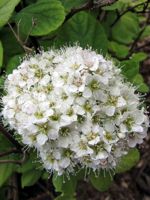Mon-Fri 9am - 5pm Mountain time
Black Elderberry vs Birch Leaf Spirea
Sambucus canadensis
Spiraea betulifolia
NOT AVAILABLE THIS SEASON - MIGHT RETURN
NOT AVAILABLE THIS SEASON - MIGHT RETURN
Black Elderberry is a deciduous shrub native to eastern North America. You can plant this shrub in moist areas and it will help stabilize your soil. You can also use it on rural properties anywhere you'd use a lilac.
Black Elderberries are considered to be partially self-pollinating. So while they will still produce some berries without cross-pollination, planting with another variety will increase yields. Consider planting with Ranch Elderberry or Bob Gordon Elderberry.
Warning: the seeds, stems, leaves, roots, and uncooked berries of the Black Elderberry are poisonous to humans when eaten in quantity. You should cook the berries to make them safe for human consumption.
Birch Leaf Meadowsweet is a small, rounded shrub, reaching 3 to 4 feet high.
In the early summer, white flowers emerge with dark green foliage. Come fall, birch-like leaves turn a kaleidoscope of red, orange, and purple adding seasonal interest.
Native to Japan and Eastern Asia, this dwarf shrub attracts butterflies and is an excellent option for the front row of a shrub border.
Black Elderberry Quick Facts
Birch Leaf Spirea Quick Facts
Toxicity: leaves, stems, and uncooked berries are poisonous to humans

